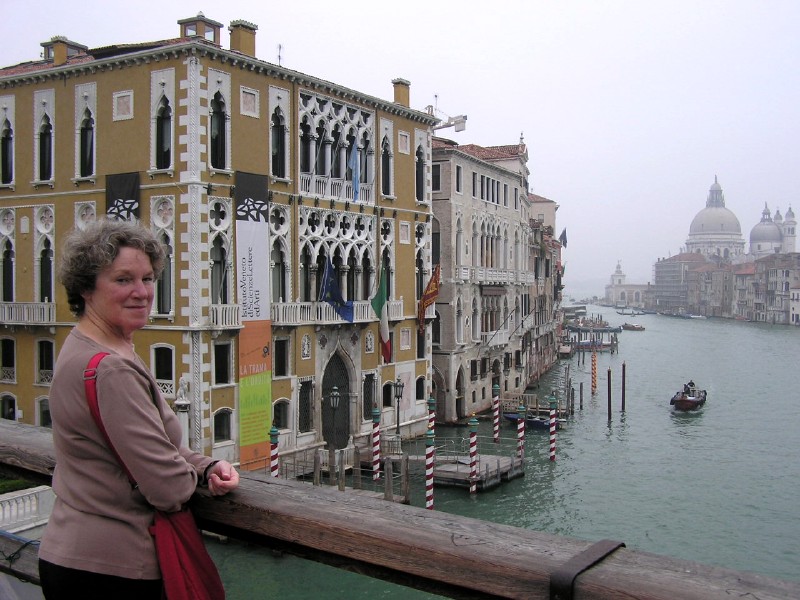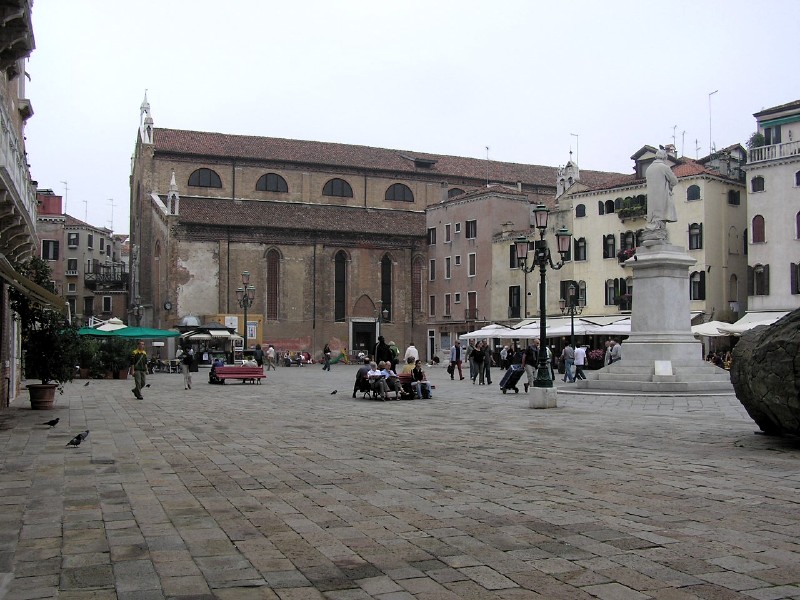
on the Ponte Accademia

Campo Stefano, il Cagalibri

S. Stefano

S. Stefano

modern scupture display
Day 13: Campo & Chiesa di S. Stefano, La Fenice, Guggenheim, Concert at S. Vidal
| The power was out in our room when we woke this morning. The staff weren't on duty yet, so we took a walk along the Zattore, expecting to deal with the problem when we returned. But when we arrived back at our room all was in order thanks to our neighbors Sally and Peggy (mother and daughter), who had dealt with everything. It's great to have competent neighbors. |
Beyond the Accademia Bridge

on the Ponte Accademia |

Campo Stefano, il Cagalibri |

S. Stefano |

S. Stefano |

modern scupture display |
This was our "free day" (no scheduled events or tours). We spent the morning exploring the area beyond the Ponte Accademia. Stopped at San Vidal Church and bought tickets for tonight's concert. Looked at masks in the Campo Santo Stefano and explored the Church of that name, which is a working church, not a tourist stop. You can't get a good photo of the Church because other buildings leave just a narrow walkway in front of it. Went on to Campo Sant' Angelo and, via a winding path (what else?), to Venice's opera house, La Fenice.
La Fenice We returned to the hotel to meet with the group going to La Fenice and returned there, via the S. Maria del Giglio traghetto across the Grand Canal. We boarded just a short block from our hotel; Fenice was a short walk from where we landed. The traghetti are inexpensive (half Euro) and go back and forth directly across the Canal. You generally stand up in the boat. We had an excellent tour of La Fenice. In February 1996 La Fenice was destroyed by fire; a pair of electricians lit the fire thinking that the slight damage would let them escape the penalities in their contract. It hadn't occurred to them that the canal behind the opera house was drained, so there was no water to contain the flames. The restoration is magnificant. The seats can be removed and the floor leveled, for dancing. There are practice rooms everywhere. We sat in the royal box (installed during the Napoleonic rule); it was all gold and red flocking - overdone but delicious. We're thinking of installing one in our TV room.
Lunch at San Stefano Karen and I returned to Campo S. Stefano and had lunch at the Gelateria of (guess what?) San Stefano. Started with spritzes and potato chips. We were joined at our table by a little hen sparrow who was then joined a couple of her chums. Karen gave them a few little bits of chips which they gobbled them up and then flew away. Pigeons prowled under the tables and would land in the dishes of tables that hadn't been cleared. We had paninis - ham and cheese. Later we were joined by the Cooks, who had stayed at the La Fenice and had lunch at the bar.
Guggenheim & San Vidal
We visited the Peggy Guggenheim collection, on the Canal between our hotel and the Accademia. Very impressive. Karen liked the Calders best, especially a magnificent silver head board. We took a nap, then went to dinner, then back to San Vidal with the Mooneys and Liz Lovink and Mary Wilson from Ottawa. Heard the chamber group Interpreti Veneziani perform Vivaldi's Four Seasons, a Mozart concerto and Folies d'Espagne by Marin Marais. Splendid -- especially the Four Seasons, each of which were led in turn by one of the four violinists. |